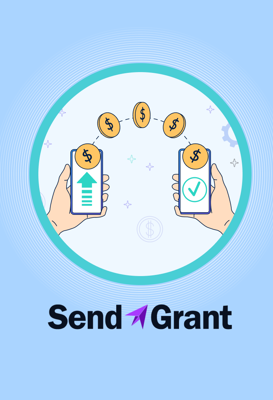Enhanced visibility:
When distribution and management are integrated, organizations can track funds from disbursement to usage, providing a comprehensive view of the funding lifecycle.

Managing and distributing funds for grants and scholarships can be tricky. It takes skill to handle money well and make sure it goes where it should. This guide will help you master fund management in a matter of minutes.
In it, we'll show you how to avoid common mistakes and use smart tools to track your funds. You'll learn why it's important to follow the rules and be open about how you handle money.
Hopefully, by the end, you'll have the know-how to manage funds like a pro. Whether you're new to fund distribution or want to improve your skills, this guide has you covered

Grant fund distribution and management are crucial processes for organizations that provide scholarships, grants, and awards. Fund distribution involves securely transferring money to recipients, while fund management ensures these funds are used properly according to program guidelines. Both aspects are essential for maintaining accountability, transparency, and efficiency in the funding process.
Effective fund management helps organizations maximize their impact by strategically allocating resources and monitoring outcomes. Meanwhile, streamlined fund distribution ensures that recipients receive their funds promptly and securely. Together, these processes form the backbone of successful grant and scholarship programs, enabling organizations to fulfill their missions and support their beneficiaries effectively.
The two most interconnected aspects of the grant funding process are fund distribution and management . These two elements work together in tandem to ensure the success of scholarship and grant programs. Fund distribution focuses on the secure and efficient transfer of money to recipients, while fund management oversees the strategic allocation and use of these funds.
When distribution and management are integrated, organizations can track funds from disbursement to usage, providing a comprehensive view of the funding lifecycle.
Real-time data on fund distribution and usage enables organizations to identify trends and make informed decisions about future funding priorities.
A well-coordinated approach ensures that funds are not only distributed correctly but also used as intended, maintaining program integrity.
Integration of distribution and management functions can reduce administrative burden and minimize errors.
Combining distribution and management data provides a more complete picture for stakeholders, donors, and auditors.
Recognizing the synergy between fund distribution and management helps organizations create more effective, transparent, and impactful funding programs. This holistic approach ensures that resources are used efficiently and that the organization's mission is advanced through every dollar distributed and managed.
Navigating grant fund distribution and management effectively requires a strategic approach and attention to detail. Here are key steps to master this process:
Establish clear guidelines: Develop comprehensive policies that outline eligibility criteria, application processes, and fund usage requirements. This provides a solid foundation for your program.
Streamline the application process: Use user-friendly online platforms to collect applications, making it easier for applicants and more efficient for your team to review.
Implement a thorough review system: Create a structured evaluation process, possibly involving multiple reviewers, to ensure a fair and consistent selection of recipients.
Set up secure fund transfer mechanisms: Utilize electronic fund transfer systems to distribute funds quickly and securely. This reduces the risk of errors and delays associated with manual processes like paper checks.
Develop a monitoring system: Implement tools to track how funds are being used. This could include regular progress reports from recipients or automated spending tracking systems.
Maintain clear communication: Keep all stakeholders informed throughout the process. This includes applicants, recipients, your internal team, and any external partners or donors.
Ensure compliance: Stay up-to-date with relevant regulations and ensure your processes adhere to legal and ethical standards.
Utilize technology: Leverage fund management software to automate and streamline various aspects of the process, from application to distribution to reporting.
Regularly evaluate and improve: Continuously assess your processes and outcomes. Gather feedback from recipients and team members to identify areas for improvement.
Plan for sustainability: Consider long-term funding strategies to ensure the continuity of your grant or scholarship program.
When you follow these steps, you can create a robust system for grant fund distribution and management that maximizes impact while minimizing risks and inefficiencies.
Ensuring compliance in fund distribution and management is crucial for maintaining the integrity, legality, and effectiveness of grant and scholarship programs. Compliance involves adhering to legal regulations, internal policies, and program guidelines throughout the funding process.
Legal protection: Compliance with relevant laws and regulations protects your organization from legal issues and potential penalties.
Maintaining tax-exempt status: For non-profit organizations, compliance is crucial for maintaining tax-exempt status.
Building trust: Demonstrating compliance builds trust with donors, recipients, and other stakeholders, enhancing your organization's reputation.
Preventing fraud: Robust compliance measures help prevent misuse of funds and fraudulent activities.
Ensuring fairness: Compliance ensures that all applicants and recipients are treated fairly and consistently.
Facilitating audits:Good compliance practices make auditing processes smoother and more straightforward.
Maximizing impact:When funds are used as intended, the impact of your program is maximized.
To ensure compliance, organizations should implement clear policies, provide regular training for staff, conduct internal audits, and use technology solutions that support compliance efforts.
When it comes to fund distribution and management, even small errors can have significant consequences. Let’s take a look at some common mistakes to avoid in managing and distributing funds.
One of the most critical errors is failing to maintain transparency throughout the fund distribution process. This can lead to mistrust among stakeholders, confusion for recipients, and difficulty in identifying potential issues. To avoid this, ensure that all processes are clearly documented and communicated. Provide regular updates to all involved parties and maintain an open line of communication for questions or concerns.
Many organizations still use outdated manual processes for fund distribution, such as paper checks or spreadsheets. This increases the risk of errors, delays, and inefficiencies. Embrace digital solutions that automate and streamline the process, reducing human error and improving speed and accuracy.
Failing to adhere to legal and regulatory requirements can result in severe consequences, including financial penalties and reputational damage. Stay informed about relevant laws and regulations, implement robust compliance processes, and regularly audit your procedures to ensure ongoing compliance.
Ineffective communication can lead to misunderstandings, delays, and frustration for all parties involved. Establish clear communication channels and protocols. Provide timely updates to recipients about the status of their funds and any changes to the distribution process.
With the increasing threat of cyber attacks, neglecting data security can put sensitive information at risk. Implement robust security measures, including encryption, multi-factor authentication, and regular security audits. Ensure that all staff are trained in cybersecurity best practices.
Without clear guidelines for fund usage, recipients may misuse funds or struggle to understand expectations. Develop and communicate comprehensive guidelines that outline how funds should be used, reporting requirements, and any restrictions.
Mostly horizontal (industry agnostic) options built for sales, lacking the nuances of healthcare workforce management.
Not listening to feedback from recipients, staff, and other stakeholders can lead to missed opportunities for improvement. Regularly solicit and act on feedback to continually enhance your processes.
While consistency is important, being too rigid can prevent you from adapting to unique situations or improving your processes over time. Strike a balance between maintaining consistent procedures and being flexible enough to address special circumstances or implement improvements.
Failing to analyze data from your fund distribution and management processes means missing out on valuable insights. Regularly review and analyze data to identify trends, assess the effectiveness of your program, and inform future decision-making.
Avoiding these common mistakes will help organizations significantly improve their fund distribution and management processes. This leads to greater efficiency, enhanced compliance, improved stakeholder satisfaction, and ultimately, a greater impact from the funds distributed. Remember, fund management is an ongoing process of improvement – regularly review your procedures and be open to making changes when necessary.

Real-time visibility: Software provides up-to-the-minute information on fund status, disbursements, and usage, allowing for better oversight and decision-making.
Automated workflows: Many repetitive tasks can be automated, reducing the risk of human error and freeing up staff time for more strategic activities.
Centralized data management:All fund-related information is stored in one secure location, making it easier to access, analyze, and report on data.
Enhanced compliance: Software can be programmed with built-in compliance checks and alerts, helping organizations adhere to regulations and internal policies.
Improved reporting: Generate detailed reports quickly and easily, satisfying stakeholder requirements and aiding in program evaluation.
Better collaboration: Many software solutions offer features that facilitate communication and collaboration among team members and with fund recipients.
Increased security: Digital platforms typically offer robust security measures to protect sensitive financial and personal information.
Scalability: As programs grow, software can easily accommodate increased volume and complexity without a proportional increase in administrative burden.
Integration capabilities: Many fund management software solutions can integrate with other systems, such as accounting software or payment gateways, for a more streamlined operation.
Leveraging software for tracking fund distribution and management helps organizations to significantly improve their efficiency, accuracy, and transparency. This not only reduces administrative burden but also enhances the overall impact of the funding program by ensuring funds are distributed and used effectively. As technology continues to evolve, adopting these tools is becoming less of a luxury and more of a necessity for organizations serious about optimizing their fund management processes.
Fund distribution software addresses several critical challenges faced by organizations managing grants, scholarships, and awards. Let’s take a look at some of the key problems solved by this technology.
Traditional methods of fund distribution often involve time-consuming manual tasks, such as paper-based applications, physical check writing, and manual record-keeping. Fund distribution software automates many of these processes, significantly reducing the time and effort required. This allows staff to focus on more strategic activities rather than getting bogged down in administrative tasks.
Without a centralized system, it can be challenging to maintain clear visibility into the status of funds, applications, and disbursements. Fund distribution software provides a transparent view of the entire process, allowing all stakeholders to access real-time information. This transparency builds trust and facilitates better communication among team members, applicants, and recipients.
Manual data entry and management are susceptible to human error, which can lead to mistakes in fund allocation, recipient information, or payment amounts. Software solutions minimize these errors through automated data validation, reducing the risk of costly mistakes and ensuring accuracy in fund distribution.
Keeping up with changing regulations and ensuring compliance can be a complex task. Fund distribution software often includes built-in compliance features, such as audit trails, automated checks, and customizable rules. This helps organizations maintain compliance with relevant laws and internal policies more easily.
Traditional methods of fund distribution often involve time-consuming manual tasks, such as paper-based applications, physical check writing, and manual record-keeping. Fund distribution software automates many of these processes, significantly reducing the time and effort required. This allows staff to focus on more strategic activities rather than getting bogged down in administrative tasks.
Once funds are distributed, it can be challenging to monitor how they're being used. Many software solutions offer features for tracking fund usage, allowing organizations to ensure that funds are being used as intended and to measure the impact of their programs more effectively.
Generating comprehensive reports for stakeholders, auditors, or internal use can be time-consuming when done manually. Fund distribution software typically includes robust reporting features, allowing for the quick generation of detailed, customizable reports.
Keeping all parties informed about the status of applications, fund disbursements, and other important updates can be difficult without a centralized system. Software solutions often include communication tools that automate notifications and facilitate better information sharing.
As programs grow, manual processes become increasingly unmanageable. Fund distribution software is designed to scale, allowing organizations to handle larger volumes of applications and disbursements without a proportional increase in administrative burden.
Handling sensitive financial and personal information requires robust security measures. Fund distribution software typically includes advanced security features such as encryption, secure access controls, and data backup, providing better protection than manual systems.
Without centralized data management, it can be challenging to gain meaningful insights from program data. Software solutions often include analytics tools that help organizations understand trends, measure program effectiveness, and make data-driven decisions.
Manual processes can lead to inconsistencies in how applications are reviewed or funds are distributed. Software enforces consistent workflows and criteria, ensuring fair and standardized treatment of all applicants and recipients.
Fund management and distribution software addresses these challenges head-on, and enables organizations to manage their programs more efficiently, effectively, and securely. This not only reduces administrative burden but also enhances the overall impact of funding programs by ensuring that resources are used optimally and recipients receive timely support.
The fund distribution and management process is a comprehensive cycle that ensures efficient allocation and use of resources. Here's an overview of the key stages:
Throughout the entire process of managing and distributing funds, effective communication is crucial. Regular updates should be provided to applicants, recipients, internal team members, and other stakeholders to ensure transparency and maintain engagement. The use of specialized fund distribution and management software can significantly streamline this process, automating many tasks, reducing errors, and providing real-time visibility into each stage. This allows organizations to manage larger programs more efficiently, ensure compliance, and focus more on strategic activities that enhance the impact of their funding efforts.
Maintaining visibility and transparency in fund distribution and management is crucial for the success and integrity of any grant, scholarship, or award program. Let’s examine why it's so important.

Building Trust: Transparency builds trust with all stakeholders – donors, recipients, regulatory bodies, and the public. When an organization is open about its processes and decisions, it demonstrates accountability and integrity, which can lead to increased support and funding.
Ensuring Accountability: Visibility in fund management ensures that all parties involved are accountable for their actions. It becomes easier to track how funds are being used and whether they're being allocated according to the stated objectives of the program.
Facilitating Compliance:Transparent processes make it easier to demonstrate compliance with legal and regulatory requirements. In the case of an audit, having clear, accessible records of all fund-related activities can significantly simplify the process.
Improving Decision-Making: When fund distribution and management processes are visible, decision-makers have access to more comprehensive information. This can lead to better-informed decisions about fund allocation, program improvements, and strategic planning.
Enhancing Efficiency: Transparency can highlight inefficiencies in the process, allowing organizations to identify and address bottlenecks or unnecessary steps. This can lead to more streamlined operations and better use of resources.
Preventing Fraud and Misuse: Visible processes and transparent reporting make it more difficult for funds to be misused or misappropriated. The risk of detection serves as a deterrent to fraudulent activities.
Encouraging Participation: When potential applicants can clearly see how funds are distributed and used, they may be more likely to apply. This can lead to a larger, more diverse pool of applicants and ultimately to more impactful use of funds.
Facilitating Collaboration: Transparency can foster better collaboration between different departments within an organization, as well as with external partners. When everyone has access to the same information, it's easier to work together towards common goals.
Demonstrating Impact: Clear visibility into how funds are used allows organizations to better demonstrate the impact of their programs. This can be crucial for attracting future funding and support.
Building a Positive Reputation: Organizations known for their transparency in fund management often enjoy a better reputation in their field. This can lead to increased opportunities for partnerships, funding, and influence.
Leveraging software for tracking fund distribution and management helps organizations to significantly improve their efficiency, accuracy, and transparency. This not only reduces administrative burden but also enhances the overall impact of the funding program by ensuring funds are distributed and used effectively. As technology continues to evolve, adopting these tools is becoming less of a luxury and more of a necessity for organizations serious about optimizing their fund management processes.

Mastering fund distribution and management is crucial for program success, and that’s where SendGrant comes in. Backed and built by the creators of SmarterSelect, SendGrant offers a comprehensive solution to streamline these processes.
With features like secure electronic fund transfers, a centralized client portal, and automated notifications, SendGrant addresses the challenges we've discussed. It ensures compliance, enhances visibility, and simplifies tracking – all while maintaining the highest standards of security.
Whether you're a grant manager, program director, or financial analyst, SendGrant can help you optimize your fund distribution and management processes. Try SendGrant today and experience the difference in efficiency, transparency, and impact.